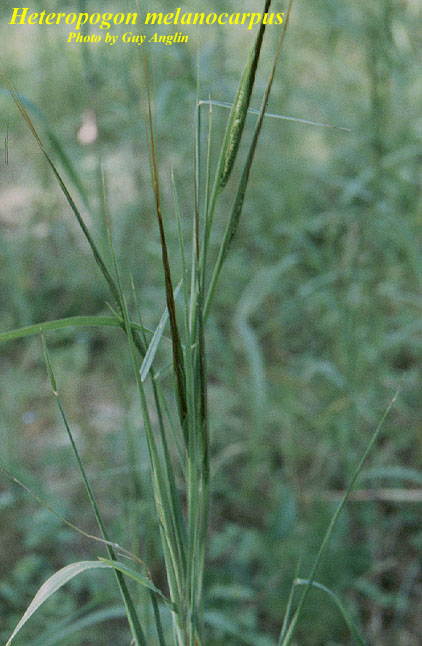Heteropogon melanocarpus
| Heteropogon melanocarpus | |
|---|---|

| |
| Photo by Guy Anglin, Atlas of Florida Vascular Plants | |
| Scientific classification | |
| Kingdom: | Plantae |
| Division: | Magnoliophyta - Flowering plants |
| Class: | Liliopsida – Monocotyledons |
| Order: | Cyperales |
| Family: | Poaceae ⁄ Gramineae |
| Genus: | Heteropogon |
| Species: | H. melanocarpus |
| Binomial name | |
| Heteropogon melanocarpus (Elliott) Elliott ex Benth. | |

| |
| Natural range of Heteropogon melanocarpus from USDA NRCS Plants Database. | |
Common name: sweet tanglehead
Contents
Taxonomic notes
Synonym: Andropogon melanocarpus Elliott USDA NRCS Plants Database
Description
Heteropogon melanocarpus is an annual graminoid.
"Coarse annual; culms 0.8-2 m tall, nodes and internodes glabrous. Leaves primarily cauline; blades to 4 dm long and 1 cm wide, long pilose above in the collar region, margins scaberulous; sheaths glabrous, occasionally glandular, upper inflated, margins usually scarious; ligules membranous, lacerate, 2-4 mm long. Inflorescence glomerate, pedunculate racemes exserted from inflated sheaths. Racemes (excluding awns) 2-4 cm long, sessile spikelet fertile and staminate, pedicellate spikelets staminate. First glume of staminate, pedicellate spikelet asymmetric, one margins winded, glandular punctate, distinctly nerved, acuminate, 12-17 mm long, 2nd glume membarceous,, enclosed by and similar to 1st; fertile and sterile lemmas hyaline, reduced, awn of fertile lemma brown hirsute, twisted, geniculate, to 10 cm long; palea absent; callus appressed brown hirsute, 2-3 mm long. Grain yellowish, linear, terete, 4 mm long." - Radford et al 1964
Distribution
Ecology
Habitat
The soils where H. melanocarpus was encountered during the study are fine sandy loams that are poorly drained with slow surface runoff and medium to very slow permeability.[1] It has also been found in wet to dry loamy sand, and seems to prefer semi-shaded to open light conditions (FSU Herbarium). H. melanocarpus can be found in annually burned savannas, as well as in disturbed habitat such as beside trails, roadsides, railroad beds, old fields, and firebreaks (FSU Herbarium). Associated species include Senna obtusifolia, Conzya pusilla, Strophostyle helvola, Bidens alba, and Andropogon glomeratus (FSU Herbarium).
Phenology
Flowering and fruiting has been observed in July through November (FSU Herbarium).
Fire ecology
This species has been found in annually burned savanna (FSU Herbarium).
It was found only in plots receiving periodic winter burning in Lewis and Harshbarger's experiment.[1]
Conservation and Management
Cultivation and restoration
Photo Gallery
References and notes
Florida State University Robert K. Godfrey Herbarium database. URL: http://herbarium.bio.fsu.edu. Last accessed: June 2014. Collectors: Loran C. Anderson, R. Komarek, James R. Burkhalter, R. K. Godfrey, James D. Ray Jr., A. H. Curtiss, Robert L. Lazor, Norlan C. Henderson, A. F. Clewell, R. A. Norris, R. F. Doren, Angela M. Reid, and K. M. Robertson. States and Counties: Florida: Bay, Columbia, Duval, Escambia, Hernando, Jefferson, Leon, Santa Rosa, Taylor, and Wakulla. Georgia: Grady.
Radford, Albert E., Harry E. Ahles, and C. Ritchie Bell. Manual of the Vascular Flora of the Carolinas. 1964, 1968. The University of North Carolina Press. 166. Print.